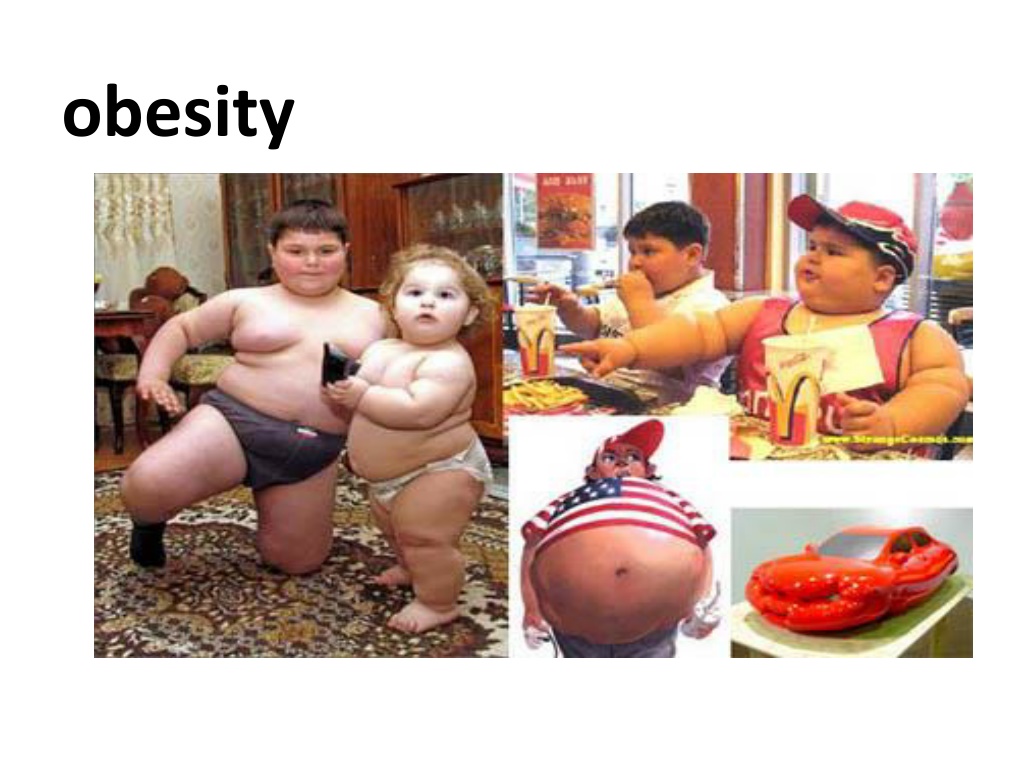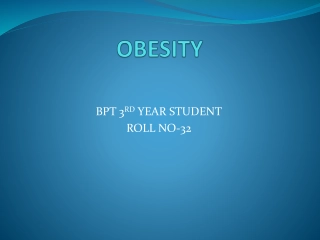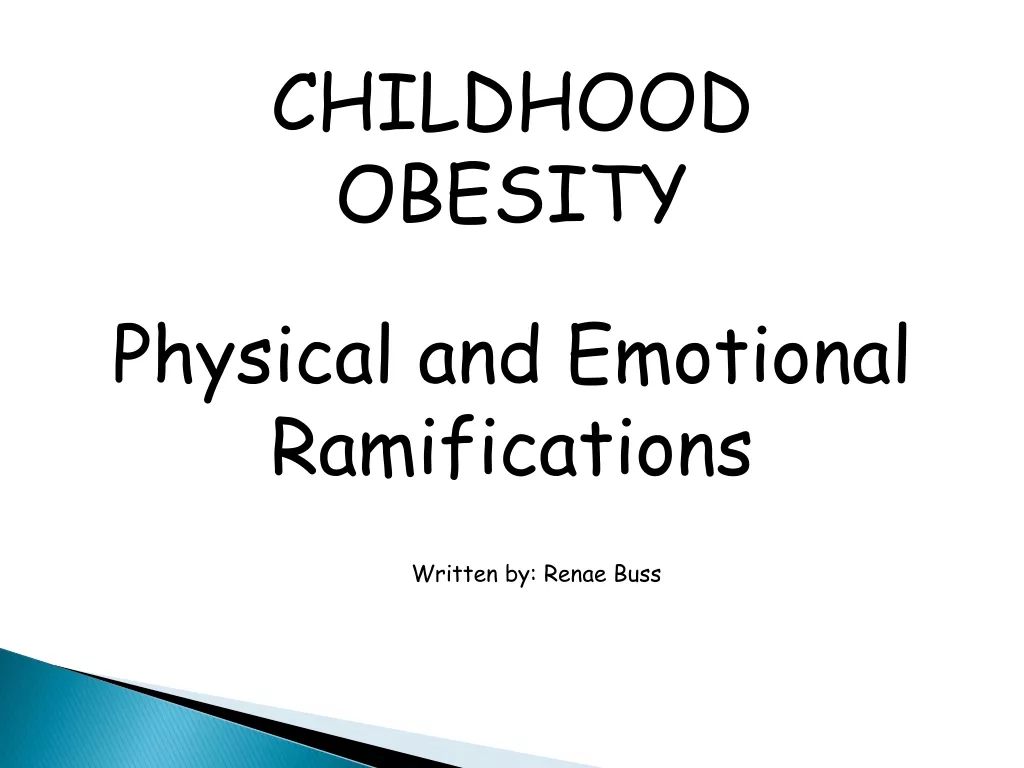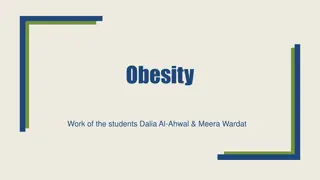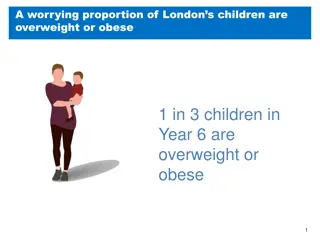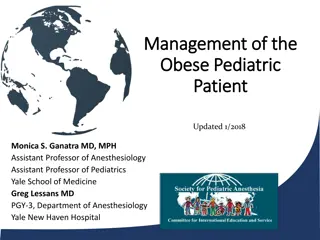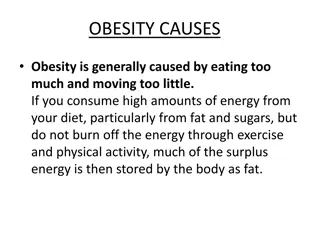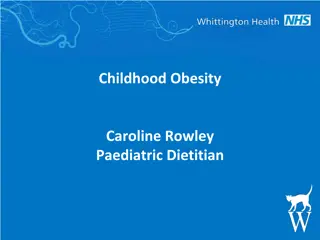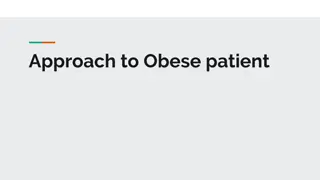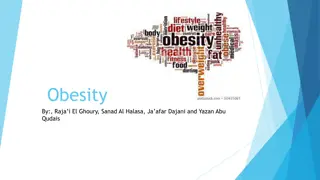Childhood Obesity: Causes, Effects, and Management
Childhood obesity is a growing concern affecting children globally. Factors such as genetics, environment, metabolism, lifestyle, and eating habits contribute to its development. The condition poses serious health risks and can lead to various diseases. Diagnosis is based on the Body Mass Index (BMI), with obesity defined as a BMI in the 95th percentile or higher. Prevention strategies include promoting healthy dietary habits, physical activity, and breastfeeding. The prevalence of obesity is on the rise across different age groups and demographics, highlighting the need for effective management and intervention.
Uploaded on Sep 30, 2024 | 0 Views
Download Presentation

Please find below an Image/Link to download the presentation.
The content on the website is provided AS IS for your information and personal use only. It may not be sold, licensed, or shared on other websites without obtaining consent from the author.If you encounter any issues during the download, it is possible that the publisher has removed the file from their server.
You are allowed to download the files provided on this website for personal or commercial use, subject to the condition that they are used lawfully. All files are the property of their respective owners.
The content on the website is provided AS IS for your information and personal use only. It may not be sold, licensed, or shared on other websites without obtaining consent from the author.
E N D
Presentation Transcript
OBJECTIVES -Definition; BMI; Causes of overweight in children and the role of genetics. -Health side-effects that include serious diseases and psychological effect. -Lines of management and prevention.
Case study A 7-year-old boy, presents to health child clinic because his parents are concerned about his weight . His parents state that his diet is generally good. His birth weight was 4 kg and his development is normal. He is on no medication. His general and systemic examination is normal .His height is125 cm (75thpercentile) and weight is 38.7 kg (99thpercentile).
Overweight and obesity are defined as abnormal or excessive fat accumulation that presents a risk to health (WHO, 2010). Childhood obesity negatively affects a child's health or wellbeing.
The National Health and Nutrition Examination Survey (NHANES) indicates that the prevalence of obesity is increasing in all pediatric age groups, in both sexes, and in various ethnic and racial groups.
Causes Many factors, including genetics, environment, metabolism, lifestyle, and eating habits, are believed to play a role in the development of obesity. However, more than 90% of cases are idiopathic; less than 10% are associated with hormonal or genetic causes.
DIAGNOSIS: Body mass index (BMI) BMI = Weight in kg (Height in m)2 -Obese children defined to have a BMI 95percentile -Overweight children defined to have a BMI 85-<95 percentile(above 91 centile)
Causes 1- Dietary Soft drink fast food Breast-feeding may protect against obesity in later life with the duration of breast-feeding inversely associated with the risk of being overweight later on.
Sedentary lifestyle Physical inactivity Stationary activities such as playing video games or watching TV. Technological activities are not the only household influences of childhood obesity.
Genetics Prader-Willi syndrome poor linear growth, development delay, dysmorphic facial features ,hypotonia and un descended testis Cushing's syndrome Hypothyroidism
Medications : Cortisol and other glucocorticoids Sulfonylureas Tricyclic antidepressants (TCAs) Monoamine oxidase inhibitors (MAOIs), such as phenelzine
Home environment Children's food choices are also influenced by family meals.
Signs and symptoms Feeling of tight clothes Excessive weight gain Shortness of breath High blood and cholesterol levels Heartburn
Complications 1.Orthopedic Slipped femoral epiphysis, Tibia vara, abnormal foot structure 2.Hypertension 3.Hypoventilation syndrome 3.Gall bladder diseases 4.Polycystic ovary 5.Hyper insulinaemia 5.Abnormal blood lipid 6.Other , asthma 7.Psychological sequelae ;low self-esteem, teasing, depression, body dissatisfaction
Evaluation 1)growth chart for weight, height, and BMI 2) medical causes of obesity 3) family eating habits, nutritional, and activity patterns 4) Complete pediatric history 5) Family history 6) Physical examination 7)Laboratory testing
MESSEGE TO PARENTS AND PATIENTS: - An imbalance between energy consumption and energy expenditure. - Obese children need high energy - An obese child tends to become an obese adult - No any drug is effective in treating childhood obesity - Obesity may be prevented and treated by: Increasing physical activity - A medical cause of obesity is more likely in the child who is obese and short. - Most children are not obese because of medical cause, but as a result of their lifestyle.
Management Lifestyle Exclusive breast-feeding is recommended in all newborn infants Medications There are no medications currently approved for the treatment of obesity in children. Orlistat a pancreatic lipase inhibitor, is approved for long-term obesity management in adult patients in the United States sibutramine may however be helpful in managing moderate obesity in adolescence.
